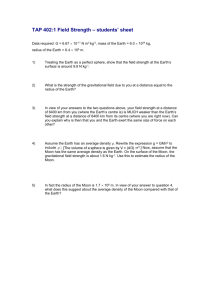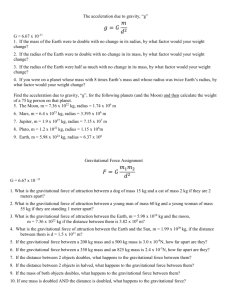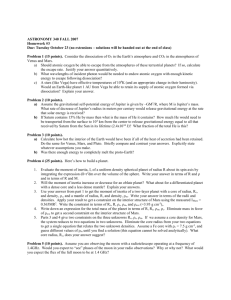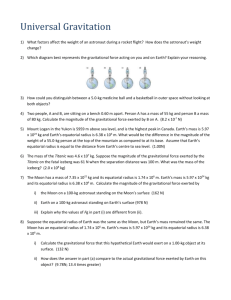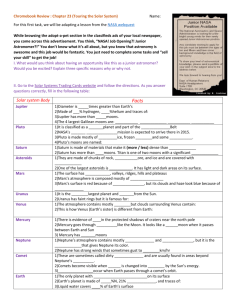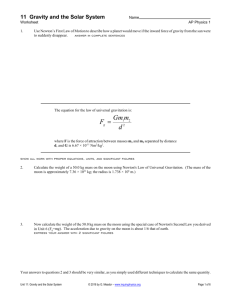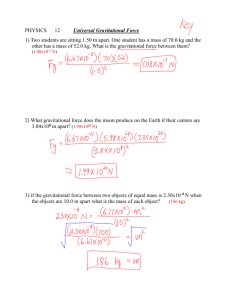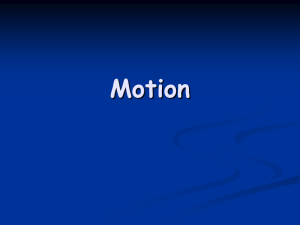Gravitation
advertisement
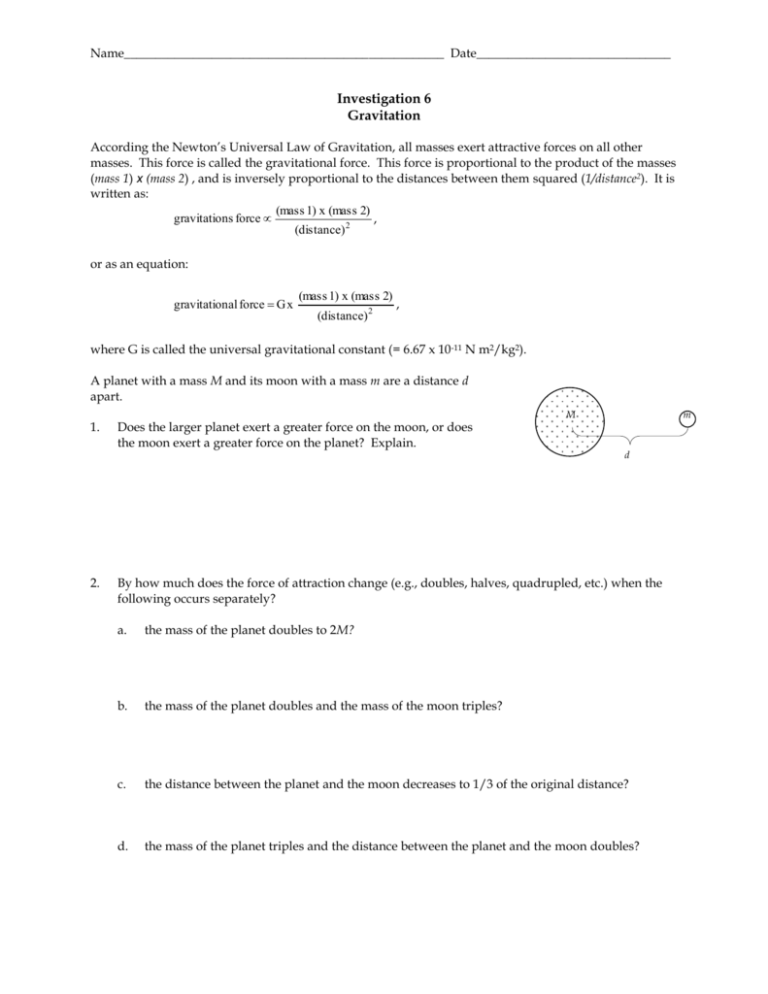
Name___________________________________________________ Date_______________________________ Investigation 6 Gravitation According the Newton’s Universal Law of Gravitation, all masses exert attractive forces on all other masses. This force is called the gravitational force. This force is proportional to the product of the masses (mass 1) x (mass 2) , and is inversely proportional to the distances between them squared (1/distance2). It is written as: (mass 1) x (mass 2) gravitations force , (distance) 2 or as an equation: gravitational force G x (mass 1) x (mass 2) (distance) 2 , where G is called the universal gravitational constant (= 6.67 x 10 -11 N m2/kg2). A planet with a mass M and its moon with a mass m are a distance d apart. 1. 2. Does the larger planet exert a greater force on the moon, or does the moon exert a greater force on the planet? Explain. M m d By how much does the force of attraction change (e.g., doubles, halves, quadrupled, etc.) when the following occurs separately? a. the mass of the planet doubles to 2M? b. the mass of the planet doubles and the mass of the moon triples? c. the distance between the planet and the moon decreases to 1/3 of the original distance? d. the mass of the planet triples and the distance between the planet and the moon doubles? These are the units for weight and mass in the three common systems of units. Weight Mass Unit in the SI System of Units Unit in the British Engineering System of Units Unit in the cgs System of Units Newtons (N) pounds (lb) dynes kilograms (kg) slugs grams (g) 2. What weighs more, one kilogram of lead or one kilogram of feathers? (Do you know why?) 3. a. How much do you weigh? Express your weight in pounds. b. Write your weight in Newtons. In order to do this, you must multiply your weight in pounds by 4.45. c. Now calculate your mass in kilograms. Remember that weight = mass x g, and that mass = (weight/g). d. The force the earth exerts on you as calculated by using Newton’s Universal Law of Gravitation m m is G 1 2 2 , where G = 6.67 x 10-11 N m2/kg2, m1 = mass of earth = 5.98 x 1024 kg, m2 = your mass d in kg, and d = radius of the earth = 6.378 x 106 m. Should the value of this force be the same as the value of your weight found in part b? Explain – do not calculate. e. 4. The gravitational force on objects on the surface of the moon is approximately 1/6 of the gravitational force the earth exerts on the same objects. 1) What is the value of your mass when you are on the moon? Express your result in kilograms. 2) How much do you weigh on the moon? Express your result in pounds and Newtons. A physics student weighs 600 N at the surface of the earth. Find her weight at the following positions: a. a distance above the surface of the earth equal to the radius of the earth. b. a distance above the surface of the earth equal to four times the radius of the earth. c. at the center of the earth. 5. Let’s take a look at what happens to the gravitational force on a student who weighs 600 N as the radius of the earth is reduced, but the mass remains the same (the density of the earth will increase). This may give you some idea of how a black hole results from the gravitational collapse of a star. The gravitational force on a person at the surface of the earth (weight) is M x m person , where mperson is the person’s mass. This is called an Force or Weight G x earth (R earth ) 2 “inverse square” force. This means that when the distance is doubled, the force is reduced by a factor of 2 squared, or four. That is, the force is ¼ of its original value. And when the distance is halved, the force is increased by a factor of 2 squared, or four. That is, the force is four times greater. If the distance is tripled, then the force is decreased by a factor of 9 (3 squared) – one-ninth of the original value. And when the distance is reduced to a third, then the force is increased by a factor of 9 – nine times larger. And so on. R So, if the radius of the earth is reduced to half of its value earth , then the 600 N student will 2 increase in weight to 4 x 600 = 2400 N. If the radius of the earth is reduced to one-third of its original R value, earth , then the student will weigh 9 x 600 = 5400 N, and so on. 3 a. Suppose the radius of the earth is reduced to one-tenth (1/10) of its original value, then how much will the student weigh at the surface of the earth? (Remember that the mass of the earth isn’t changing.) b. When the radius of the earth is reduced to about one millimeter (remember, all of the mass of the earth is contained within that 1 mm radius sphere), the earth theoretically becomes a black R earth . How much does the student now hole. In this case, the radius of the earth is 10,000,000 ,000 weigh? (Obviously, this can’t happen, but it is fun to speculate.)
